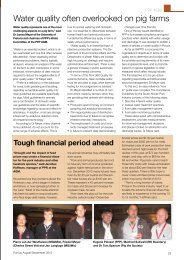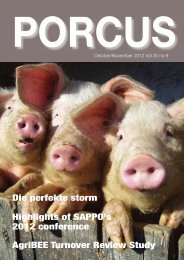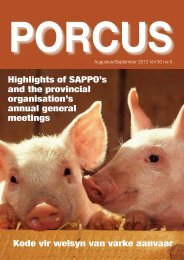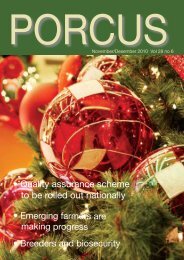porcus - sappo
porcus - sappo
porcus - sappo
Create successful ePaper yourself
Turn your PDF publications into a flip-book with our unique Google optimized e-Paper software.
utrition<br />
The year ahead is again characterised with high volatility<br />
in agricultural markets which is driven by a number<br />
of external macro-economic factors. The strengthening<br />
of the link between energy and agricultural markets is<br />
probably the key driver behind increased volatility. In the<br />
medium term, the Rand exchange rate against the major<br />
currencies remains a key driver which impacts on both the<br />
cost of inputs and the output price. The general consensus<br />
is that the Rand exchange rate will remain volatile with<br />
a depreciating trend against the Dollar and Euro, mainly<br />
due to the raising concerns of fi nancial markets in the<br />
Euro Zone and the United States. Domestic stock levels<br />
of maize will remain under pressure until the new marketing<br />
season. Therefore, the price of key commodities could<br />
trace import parity prices for another couple of months.<br />
The high yellow maize price together with other expensive<br />
inputs place signifi cant pressure on the profi t margins of<br />
livestock farmers due to higher feed costs.<br />
Farm level analysis<br />
4<br />
Market conditions<br />
Information supplied by Divan van der Westhuizen of the Bureau of Food and Agricultural Policy (BFAP)<br />
Figure 1: Index for requisites and auction prices<br />
The requisites and auction price index focuses on the pork<br />
auction price on the hook and the pork input cost index. The<br />
key driver in the pork requisites index is the yellow maize SAFEX<br />
price, followed by the soybean cake price. The latest update<br />
from the BFAP pork industry index analysis for January 2012 includes<br />
the latest projections based on the BFAP livestock model.<br />
Due to the higher cost of maize it is projected that the pork<br />
auction price on hook could increase by 20% from 2011 to<br />
2012. The average projected pork auction price on hook for<br />
2012 is R20.61/kg. The input/requisites index for pork production<br />
may increase by eleven percent from 2011 to 2012. The<br />
index value (base year = 2000) for the requisites and pork auction<br />
price in January 2012 was 311.9% and 265.1% respectively.<br />
The pork to maize price ratio provides an indication of profi tability<br />
of pork producers. A sideways movement occurred from<br />
December to January in both the ratios for PP and BP products.<br />
A higher maize price together with higher auction prices for BP<br />
and PP products caused the sideways movement. The ratio for<br />
PP products has increased from November towards January<br />
by two percent. However, a slight decrease of 3.6% occurred in<br />
the BP ratio. The ratio for PP and BP meat classes in January<br />
were 8.74 and 7.78 respectively (Figure 2). For the same period<br />
in 2011, the ratios were 11.10 and 10.65 respectively, which<br />
indicates that profi tability margins were higher in January 2011.<br />
Figure 2: Pork to maize price ratio<br />
The bullish trend continued in the yellow maize market mainly due<br />
to local stock levels which remained under pressure. Local supply<br />
and demand will play a signifi cant role in grain markets in the medium<br />
term which implies that the yellow maize price will probably<br />
follow import parity prices until the new stock arrives in April/May.<br />
The yellow maize price traded at R2 360/ton in November 2011<br />
where it further increased by 10.99% towards January. The yellow<br />
maize price traded on average at R2 620/ton in January 2012. On<br />
a year-to-year basis, the yellow maize price in January was 77%<br />
higher than in the same period in 2011. Given normal mid-summer<br />
weather conditions, the current crop will compensate for low stock<br />
levels and the price of key commodities may trade back to export<br />
parity levels towards June/July.<br />
The auction price of pork products reacted to the increase in<br />
the yellow maize, especially during the last two months of 2011<br />
(Figure 3). Towards January, the price response was at a slower<br />
pace. The price of PP quality meat in the middle of January was<br />
R22.91/kg, approximately 2.69% higher than December. For the<br />
same period in 2011, the price of PP pork meat was R16.40/kg.<br />
Figure 3: Pork price and YM SAFEX price<br />
International<br />
Pork exports to Russia have continued its increasing trend during<br />
2011. Increased imports of fresh and frozen pork, mainly from<br />
Canada and the United States were a result of the increasing<br />
demand in Russia. Brazil, which is a major supplier of pork meat<br />
to Russia, has lost some of its market share due to increasing<br />
competition from the Euro Zone and a temporary import ban on<br />
some Brazilian products from processing plants in three states.<br />
In addition, pork imports from Germany were temporarily banned<br />
Porcus Januarie/Februarie 2012







